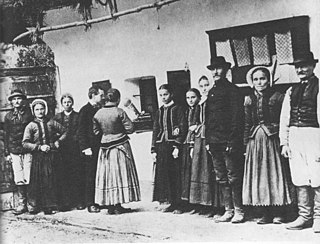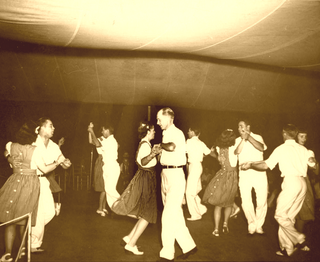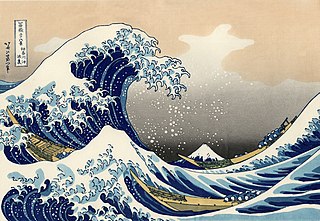Country is a music genre originating in the Southern and Southwestern United States. First produced in the 1920s, country music primarily focuses on working class Americans and blue-collar American life.

Folk music is a music genre that includes traditional folk music and the contemporary genre that evolved from the former during the 20th-century folk revival. Some types of folk music may be called world music. Traditional folk music has been defined in several ways: as music transmitted orally, music with unknown composers, music that is played on traditional instruments, music about cultural or national identity, music that changes between generations, music associated with a people's folklore, or music performed by custom over a long period of time. It has been contrasted with commercial and classical styles. The term originated in the 19th century, but folk music extends beyond that.
Musicology is the scholarly analysis and research-based study of music. Musicology departments traditionally belong to the humanities, although some music research is scientific in focus. Some geographers and anthropologists have an interest in musicology, so the social sciences also have an academic interest. A scholar who participates in musical research is a musicologist.

The waltz, meaning "to roll or revolve") is a ballroom and folk dance, normally in triple, performed primarily in closed position.
World music is an English phrase for styles of music from non-Western countries, including quasi-traditional, intercultural, and traditional music. World music's broad nature and elasticity as a musical category pose obstacles to a universal definition, but its ethic of interest in the culturally exotic is encapsulated in Roots magazine's description of the genre as "local music from out there".

A square dance is a dance for four couples, or eight dancers in total, arranged in a square, with one couple on each side, facing the middle of the square. Square dances are part of a broad spectrum of dances known by various names: country dances, traditional dances, folk dances, barn dances, ceilidh dances, contra dances, Playford dances, etc. These dances appear in over 100 different formations, of which the Square and the Longways Set are by far the most popular formations.

The culture of Japan has changed greatly over the millennia, from the country's prehistoric Jōmon period, to its contemporary modern culture, which absorbs influences from Asia and other regions of the world.

Much has been learned about early music in Norway from physical artifacts found during archaeological digs. These include instruments such as the lur. Viking and medieval sagas also describe musical activity, as do the accounts of priests and pilgrims from all over Europe coming to visit St Olav's grave in Trondheim.
Romania has a multicultural music environment which includes active ethnic music scenes. Traditional Romanian folk music remains popular, and some folk musicians have come to national fame.

The music of Taiwan reflects the diverse culture of Taiwanese people. Taiwan has undergone several economic, social, and political changes through its cultural history, and Taiwanese music reflects those issues in its way. The music of the country has adopted a mixed style. As a country rich in Chinese folk culture and with many indigenous tribes with their own distinct artistic identity, various folk music styles are appreciated in Taiwan. In addition, people in Taiwan highly appreciate various style of Western classical music and pop music. Taiwan is a major Mandopop hub.

The music of Cyprus includes a variety of traditional, Western classical and Western popular genres. Cypriot traditional music is similar to the traditional music of Greece with Turkish and Arab influences, and includes dances like sousta, syrtos, ballos, tatsia, antikristos, arabiye, karotseris, sinalik, chiftetteli, zeimbekiko and the mandra dance.

The Suzuki method is a music curriculum and teaching philosophy dating from the mid-20th century, created by Japanese violinist and pedagogue, Shinichi Suzuki (1898–1998). The method claims to create an environment for learning music which parallels the linguistic environment of acquiring a native language. Suzuki believed that this environment would also help to foster good moral character.

Kuwait is well known in the region for its exploration of many different and new forms of music and dance. Kuwait is the birthplace of various popular musical genres such as sawt. Kuwait is widely considered the centre of traditional music in the GCC region.

Tim O'Brien is an American country and bluegrass musician. In addition to singing, he plays guitar, fiddle, mandolin, banjo, bouzouki and mandocello. He has released more than ten studio albums, in addition to charting a duet with Kathy Mattea entitled "The Battle Hymn of Love", a No. 9 hit on the Billboard Hot Country Singles & Tracks charts in 1990. In November 2013 he was inducted into the West Virginia Music Hall of Fame.

Indigenous music of Australia comprises the music of the Aboriginal and Torres Strait Islander peoples of Australia, intersecting with their cultural and ceremonial observances, through the millennia of their individual and collective histories to the present day. The traditional forms include many aspects of performance and musical instrumentation that are unique to particular regions or Aboriginal Australian groups; and some elements of musical tradition are common or widespread through much of the Australian continent, and even beyond. The music of the Torres Strait Islanders is related to that of adjacent parts of New Guinea. Music is a vital part of Indigenous Australians' cultural maintenance.

Alberta has a diverse music scene of pop, rock, country, jazz, folk, caribbean, classical, and blues music. Music festivals in the Summers are representing these genres. Choral music, ethnic music of many nationalities, all are found in Alberta.
Erdenechimeg Luvsannorov is an ethnomusicologist and researcher.
Norwegian National Association for Traditional Music and Dance(Norsk Folkemusikk- og Danselag) is a nationwide organization that aims to support the folk music and rural dance tradition in Norway.

An organist is a musician who plays any type of organ. An organist may play solo organ works, play with an ensemble or orchestra, or accompany one or more singers or instrumental soloists. In addition, an organist may accompany congregational hymn-singing and play liturgical music.
The history and development of jazz in Bulgaria was significantly influenced by the cultural and political changes in the country during the 20th century, which led to the emergence of a genre blending western jazz styles with Bulgarian folk music influences.













